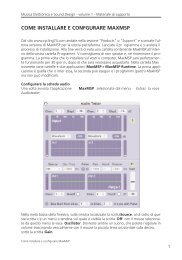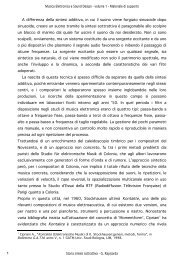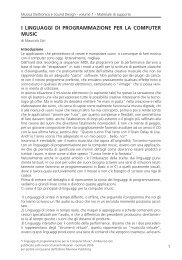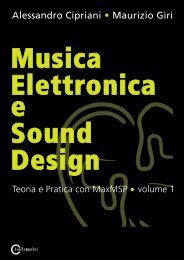programming with max/msp - Virtual Sound
programming with max/msp - Virtual Sound
programming with max/msp - Virtual Sound
Create successful ePaper yourself
Turn your PDF publications into a flip-book with our unique Google optimized e-Paper software.
Chapter 2T - Additive and vector synthesis<br />
In order to see the evolution of components over time, we can use a graph<br />
called a sonogram (which is also sometimes called a spectrogram), in which<br />
frequencies are shown on the y-axis and time is shown on the x-axis (as demonstrated<br />
in Figure 2.2c). The lines corresponding to frequency components<br />
become darker or lighter as their amplitude changes in intensity. In this particular<br />
example, there are only four lines, since it is a sound <strong>with</strong> a simple fixed<br />
spectrum.<br />
frequency in Hz<br />
1200<br />
900<br />
600<br />
300<br />
time<br />
Fig. 2.2c A sonogram (also called a spectrogram)<br />
Now we will consider a process in which, instead of decomposing a complex<br />
sound into sine waves, we aim to do the opposite: to fashion a complex sound<br />
out of a set of sine waves.<br />
This technique, which should in theory enable us to create any waveform at all<br />
by building up a sum of sine waves, is called additive synthesis, and is shown<br />
in diagrammatic form in Figure 2.3.<br />
Fig. 2.3 A sum of signals output by sine wave oscillators<br />
In Figure 2.4, two waves, A and B, and their sum, C, are shown in the time<br />
domain.<br />
from “Electronic Music and <strong>Sound</strong> Design” Vol. 1 by Alessandro Cipriani and Maurizio Giri<br />
© ConTempoNet 2010 - All rights reserved<br />
2T<br />
189







